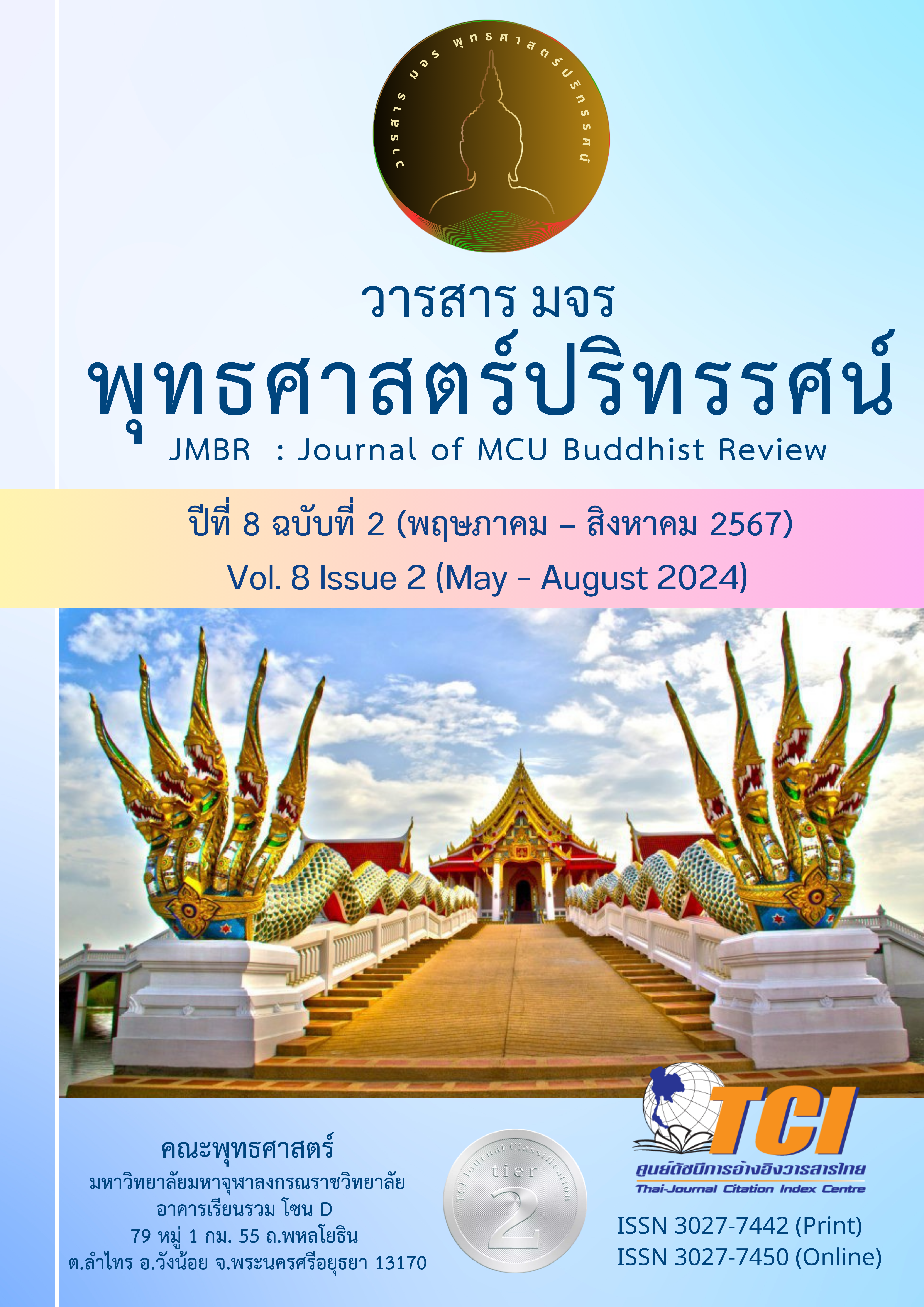ศึกษาวิเคราะห์การบริหารขุมทรัพย์ในนิธิกัณฑสูตร
Main Article Content
บทคัดย่อ
บทความวิจัยนี้มีวัตถุประสงค์ 1) เพื่อศึกษาโครงสร้างและเนื้อหาในนิธิกัณฑสูตร 2) เพื่อศึกษาวิธีการบริหารขุมทรัพย์ในนิธิกัณฑสูตร 3) เพื่อวิเคราะห์การบริหารขุมทรัพย์ในนิธิกัณฑสูตร เป็นการวิจัยเชิงเอกสาร ด้วยวิธีค้นคว้าจากเอกสารพระไตรปิฎกภาษาไทย ฉบับมหาจุฬาลงกรณราชวิทยาลัย พุทธศักราช 2539 และเอกสารที่เกี่ยวข้อง โดยวิเคราะห์ข้อมูลเนื้อหาเขียนบรรยายเชิงพรรณนา
ผลการวิจัยพบว่า 1) โครงสร้างและเนื้อหาในนิธิกัณฑสูตร จัดเป็นพุทธพจน์ประเภทคาถา อยู่ในพระไตรปิฎกภาษาไทย ฉบับมหาจุฬาลงกรณราชวิทยาลัย เล่มที่ 25 ในหมวดขุททกนิกาย ขุททกปาฐะ ตรัสสอนเรื่องการฝังขุมทรัพย์ โดยแบ่งทรัพย์ออกเป็นสองอย่างคือ ทรัพย์ภายนอก ได้แก่ ทรัพย์สินเงินทองซึ่งเป็นสิ่งที่ไม่มั่นคง และทรัพย์ภายใน คือ บุญกุศลคุณธรรม ได้แก่ ทาน ศีล สัญญมะ ทมะ จัดเป็นอริยทรัพย์สามารถติดตามตนตลอดไป และส่งผลในเรื่องมนุษย์สมบัติ สวรรค์สมบัติ นิพพานสมบัติ 2) วิธีการบริหารขุมทรัพย์ในนิธิกัณฑสูตร พระสูตรนี้ให้ความสำคัญกับขุมทรัพย์ภายใน ที่เป็นบุญกุศลเกี่ยวกับการทำทาน การรักษาศีล การสำรวมอินทรีย์ การรู้จักข่มใจข่มกิเลสระงับความโลภ โกรธ หลง โดยปฏิบัติต่อสิ่งที่สมควร ประกอบด้วย พระภิกษุสงฆ์ บิดามารดา ญาติพี่น้อง มิตรสหาย หรือสถานที่อันควรสักการะบูชา 3) การบริหารขุมทรัพย์ในนิธิกัณฑสูตรวิเคราะห์ได้ว่า ทรงสอนให้รู้จักแสวงหาทรัพย์ภายในที่บุญกุศลไว้เป็นต้นทุนในภพหน้า ทำให้เกิดความตระหนักเห็นคุณค่าของหลักธรรมพื้นฐานสามัญที่ปัจจัยนำส่งให้ได้รับผลมนุษย์สมบัติ สวรรค์สมบัติ และนิพพานสมบัติ ตามเหตุปัจจัยของแต่ละบุคคลได้สร้างสมไว้ ธรรมในพระสูตรนี้จึงเป็นการคุ้มครองตนให้ตั้งตนอยู่ในความไม่ประมาทในธรรม
Article Details

อนุญาตภายใต้เงื่อนไข Creative Commons Attribution-NonCommercial-NoDerivatives 4.0 International License.
- บทความที่ได้รับการตีพิมพ์เป็นลิขสิทธิ์ของวารสาร มจร พุทธศาสตร์ปริทรรศน์
- ข้อความใดๆ ที่ปรากฎในบทความที่ได้รับการตีพิมพ์ในวารสาร ถือเป็นความรับผิดชอบของผู้เขียนบทความ และข้อคิดเห็นนั้นไม่ถือว่าเป็นทัศนะและความรับผิดชอบของกองบรรณาธิการวารสาร มจร พุทธศาสตร์ปริทรรศน์
เอกสารอ้างอิง
พระครูประสิทธิสรคุณ (บุรินทร์ฐิตธมฺโม). (2545). การศึกษาเชิงวิเคราะห์เรื่องความไม่ประมาทในพระพุทธศาสนาเถรวาท. วิทยานิพนธ์หลักสูตรพุทธศาสตรมหาบัณฑิต บัณฑิตวิทยาลัย: มหาวิทยาลัยมหาจุฬาลงกรณราชวิทยาลัย.
พระมหาสุชิน ตสีโล (นราเกตุ). (2558). ศึกษาความสัมพันธ์ระหว่างศีลกับการบรรลุธรรม. วิทยานิพนธ์หลักสูตรพุทธศาสตรมหาบัณฑิต บัณฑิตวิทยาลัย: มหาวิทยาลัยมหาจุฬาลงกรณราชวิทยาลัย.
พระวุฒิไกร สิริสาโร (ตาไธสง). (2561). ศึกษาประโยชน์ 3 ที่มีผลต่อการเจริญวิปัสสนาภาวนา. วิทยานิพนธ์หลักสูตรพุทธศาสตรมหาบัณฑิต บัณฑิตวิทยาลัย: มหาวิทยาลัยมหาจุฬาลงกรณราชวิทยาลัย.
มหาจุฬาลงกรณราชวิทยาลัย. (2539). พระไตรปิฎกภาษาไทย ฉบับมหาจุฬาลงกรณราชวิทยาลัย. กรุงเทพฯ: มหาจุฬาลงกรณราชวิทยาลัย.
มหาจุฬาลงกรณราชวิทยาลัย. (2550). อรรถกถา ฉบับมหาจุฬาลงกรณราชวิทยาลัย. กรุงเทพฯ: มหาจุฬาลงกรณราชวิทยาลัย.
ราชบัณฑิตยสถาน. (2525). พจนานุกรมฉบับราชบัณฑิตยสถาน พ.ศ.2525. กรุงเทพฯ: สำนักพิมพ์ อักษรเจริญทัศน์.
สมเด็จพระพุทธโฆษาจารย์ (ป.อ.ปยุตฺโต). (2565). พจนานุกรมศาสตร์ ฉบับประมวลศัพท์. พิมพ์ครั้งที่ 37. กรุงเทพฯ: บริษัท สหธรรมิก จำกัด.
สมเด็จพระพุทธโฆษาจารย์ (ป.อ.ปยุตฺโต). (2556). ร่ำรวย ยิ่งใหญ่ เลื่อนลอย เพื่ออะไร. พิมพ์ครั้งที่ 4. กรุงเทพฯ: บริษัท สหธรรมิก จำกัด.
สิรีรัศมิ์ สิงห์สนธิ. (2564). การศึกษาวิเคราะห์กุศลกรรมในคัมภีร์วิมานวัตถุ. วิทยานิพนธ์หลักสูตรพุทธศาสตรมหาบัณฑิต บัณฑิตวิทยาลัย: มหาวิทยาลัยมหาจุฬาลงกรณราชวิทยาลัย.


